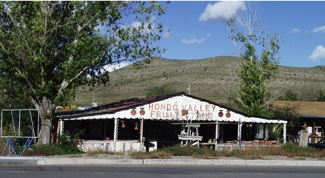Making a Living in the Hondo Valley

The Hondo Valley
Flowing eastward down from the Sacramento Mountains to the Pecos River Valley are the Rio Ruidoso and the Rio Hondo. The valley carved by these streams, called the Hondo Valley, has long been a thoroughfare for humans living in and traveling through the area. Native Americans traveled up and down the valley, hunting and gathering, fishing, and trading and warring with their neighbors. Americans of European descent - referred to here as Euroamericans - have moved through and settled in the valley for more than a century. The wagon road that eventually became US 70 has been the lifeline for travel across the Sacramentos and for communication and interaction among the valley's inhabitants. Over the past several decades, the population of the Hondo Valley has grown, and the valley's picturesque terrain has attracted more and more visitors over the years. The resulting increase in traffic along US 70 prompted the New Mexico Department of Transportation to implement plans for a widening of US 70 between Ruidoso Downs and Riverside. Because the highway widening would destroy all or portions of many archaeological sites, part of this project involved archaeological investigations, including surveys to identify new sites and record the current conditions of sites that were already known, and excavations to collect information from these sites before they were impacted by construction.
Background:
People have lived in the Hondo Valley for at least 12,000 years. For the vast majority of that time, the inhabitants were Native Americans, whose ancestors came from Asia. Because most of the area's Native American inhabitants lived at a time before there were any written accounts of the area, we refer to them as prehistoric peoples. Their traces are scattered up and down the valley - stone tools and pottery fragments lying on and under the ground surface; remains of storage pits, hearths, and houses; and accumulations of ash and debris in caves and on dry ground surfaces beneath cliff overhangs (called rock shelters by archaeologists). This is the timeworn record of an unwritten past, the silent testimony to a muted history.



Making a Living in the Hondo Valley
Created by:
Carol J. Ellick, M.A., RPA
SRI Foundation
Director, Outreach and Education
333 Rio Rancho Dr. NE #103,
Rio Rancho, NM 87124
Making a Living in the Hondo Valley
was created under a grant from
the New Mexico Department of Transportation
through SWCA Environmental, Inc.
Permission is granted for
printing and copying these materials
for use in educational contexts